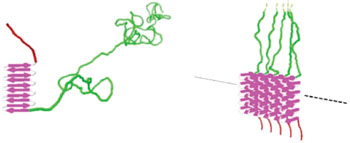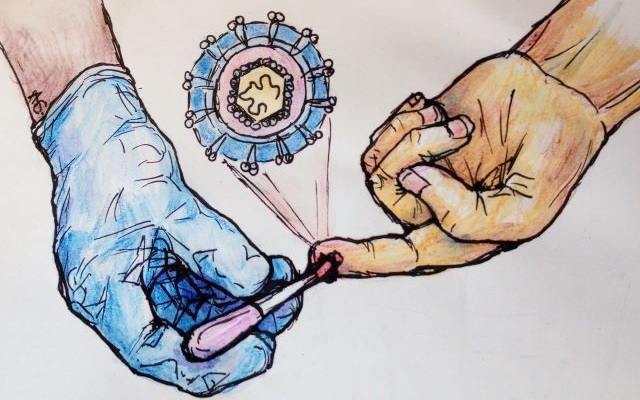Synthetic Virus Designed to Enhance Delivery of New Generation of Pharmaceutical Agents
|
By LabMedica International staff writers Posted on 10 Sep 2014 |

Image: Design of the minimal viral coat protein C-Sn-B (Photo courtesy of Wageningen University).
Dutch scientists have effectively developed an artificial virus that may be used for the delivery of a new generation of pharmaceutical agents, consisting of large biomolecules, by packaging them in a natural manner and delivering them to diseased cells. The artificial virus was developed according to a new theoretic determination of how viruses work, according to the researchers.
The findings were published in the August 31, 2014, issue of the journal Nature Nanotechnology. Specifically, the researchers, from Wageningen University (The Netherlands), along with colleagues from the University of Leiden (The Netherlands), Eindhoven University of Technology (The Netherlands), and Radboud University Nijmegen (The Netherlands) think that the artificial virus technology could be useful for gene therapy.
Standard drugs consist of comparatively small molecules that typically arrive at the desired location without too much difficulty. This is more difficult for newer types of drugs that are being developed; these are comprised of large biomolecules such as proteins and genetic material (i.e., DNA and RNA). For example, to use DNA in gene therapy, the molecule must be delivered to diseased cells in its totality to be effective. However, DNA is inherently incapable of penetrating cells and is rapidly degraded. Therefore natural viruses that have been rendered harmless are used as so-called vectors. These can enter cells efficiently and deliver the therapeutic DNA or RNA molecules.
However, the process of rendering natural viruses harmless still requires improvement. Unwanted side effects have been a hurdle. Therefore, research is also being conducted into alternative virus-like vectors based on synthetic molecules. Regrettably, these have been less effective because it is difficult to precisely duplicate the many behaviors used by viruses. A first important step in mimicking viruses is the effective packaging of individual DNA molecules with a protective coat of smaller molecules. This sounds easier than it is, the researchers reported. Up to now, packing individual DNA molecules with a protective coating of synthetic molecules has not yet been accomplished.
The researchers decided to design and construct artificial viral coat proteins, instead of using synthetic chemistry to coat individual DNA molecules. As part of their study, they used recent theoretic insights into the key aspects of the process of packaging genetic material by natural viral coat proteins. The researchers converted each of these key features into various protein blocks with simple structures. The amino acid sequence of the protein blocks was inspired by natural proteins such as collagen and silk. Artificial viral coat proteins designed in this manner were produced using the natural processes of yeast cells. When the proteins were combined with DNA, they spontaneously formed a highly protective protein coat around each DNA molecule, thus creating artificial viruses. The formation process of the artificial viruses is similar in many ways to that of natural viruses, such as the tobacco mosaic virus, which served as a model for the artificial virus.
This first generation of artificial viruses was found to be as effective as the current methods for delivering DNA to host cells based on synthetic molecules. But the great precision by which DNA molecules are packaged in the artificial virus offers many possibilities to now also build in other virus tricks, the researchers write. In the future, these techniques can hopefully lead to safe and effective approaches for delivering new generations of pharmaceuticals, especially in gene therapy. Moreover, these artificial viruses can also be developed for the many other applications in which viruses are now being used in fields such as biotechnology and nanotechnology.
The artificial viral proteins were designed and produced by scientists of Wageningen UR (University & Research Center). They worked in collaboration with colleagues from Eindhoven University of Technology and Leiden University, who provided contributions based on the theory of spontaneous formation of virus particles, and helped to visualize the resulting artificial virus particles, and partners from Radboud University Nijmegen, who assessed the penetration of the artificial virus particles into living cells.
Related Links:
Wageningen University
University of Leiden
Radboud University Nijmegen
The findings were published in the August 31, 2014, issue of the journal Nature Nanotechnology. Specifically, the researchers, from Wageningen University (The Netherlands), along with colleagues from the University of Leiden (The Netherlands), Eindhoven University of Technology (The Netherlands), and Radboud University Nijmegen (The Netherlands) think that the artificial virus technology could be useful for gene therapy.
Standard drugs consist of comparatively small molecules that typically arrive at the desired location without too much difficulty. This is more difficult for newer types of drugs that are being developed; these are comprised of large biomolecules such as proteins and genetic material (i.e., DNA and RNA). For example, to use DNA in gene therapy, the molecule must be delivered to diseased cells in its totality to be effective. However, DNA is inherently incapable of penetrating cells and is rapidly degraded. Therefore natural viruses that have been rendered harmless are used as so-called vectors. These can enter cells efficiently and deliver the therapeutic DNA or RNA molecules.
However, the process of rendering natural viruses harmless still requires improvement. Unwanted side effects have been a hurdle. Therefore, research is also being conducted into alternative virus-like vectors based on synthetic molecules. Regrettably, these have been less effective because it is difficult to precisely duplicate the many behaviors used by viruses. A first important step in mimicking viruses is the effective packaging of individual DNA molecules with a protective coat of smaller molecules. This sounds easier than it is, the researchers reported. Up to now, packing individual DNA molecules with a protective coating of synthetic molecules has not yet been accomplished.
The researchers decided to design and construct artificial viral coat proteins, instead of using synthetic chemistry to coat individual DNA molecules. As part of their study, they used recent theoretic insights into the key aspects of the process of packaging genetic material by natural viral coat proteins. The researchers converted each of these key features into various protein blocks with simple structures. The amino acid sequence of the protein blocks was inspired by natural proteins such as collagen and silk. Artificial viral coat proteins designed in this manner were produced using the natural processes of yeast cells. When the proteins were combined with DNA, they spontaneously formed a highly protective protein coat around each DNA molecule, thus creating artificial viruses. The formation process of the artificial viruses is similar in many ways to that of natural viruses, such as the tobacco mosaic virus, which served as a model for the artificial virus.
This first generation of artificial viruses was found to be as effective as the current methods for delivering DNA to host cells based on synthetic molecules. But the great precision by which DNA molecules are packaged in the artificial virus offers many possibilities to now also build in other virus tricks, the researchers write. In the future, these techniques can hopefully lead to safe and effective approaches for delivering new generations of pharmaceuticals, especially in gene therapy. Moreover, these artificial viruses can also be developed for the many other applications in which viruses are now being used in fields such as biotechnology and nanotechnology.
The artificial viral proteins were designed and produced by scientists of Wageningen UR (University & Research Center). They worked in collaboration with colleagues from Eindhoven University of Technology and Leiden University, who provided contributions based on the theory of spontaneous formation of virus particles, and helped to visualize the resulting artificial virus particles, and partners from Radboud University Nijmegen, who assessed the penetration of the artificial virus particles into living cells.
Related Links:
Wageningen University
University of Leiden
Radboud University Nijmegen
Latest BioResearch News
- Genome Analysis Predicts Likelihood of Neurodisability in Oxygen-Deprived Newborns
- Gene Panel Predicts Disease Progession for Patients with B-cell Lymphoma
- New Method Simplifies Preparation of Tumor Genomic DNA Libraries
- New Tool Developed for Diagnosis of Chronic HBV Infection
- Panel of Genetic Loci Accurately Predicts Risk of Developing Gout
- Disrupted TGFB Signaling Linked to Increased Cancer-Related Bacteria
- Gene Fusion Protein Proposed as Prostate Cancer Biomarker
- NIV Test to Diagnose and Monitor Vascular Complications in Diabetes
- Semen Exosome MicroRNA Proves Biomarker for Prostate Cancer
- Genetic Loci Link Plasma Lipid Levels to CVD Risk
- Newly Identified Gene Network Aids in Early Diagnosis of Autism Spectrum Disorder
- Link Confirmed between Living in Poverty and Developing Diseases
- Genomic Study Identifies Kidney Disease Loci in Type I Diabetes Patients
- Liquid Biopsy More Effective for Analyzing Tumor Drug Resistance Mutations
- New Liquid Biopsy Assay Reveals Host-Pathogen Interactions
- Method Developed for Enriching Trophoblast Population in Samples
Channels
Clinical Chemistry
view channel
Blood Test Could Predict and Identify Early Relapses in Myeloma Patients
Multiple myeloma is an incurable cancer of the bone marrow, and while many patients now live for more than a decade after diagnosis, a significant proportion relapse much earlier with poor outcomes.... Read more
Compact Raman Imaging System Detects Subtle Tumor Signals
Accurate cancer diagnosis often depends on labor-intensive tissue staining and expert pathological review, which can delay results and limit access to rapid screening. These conventional methods also make... Read moreMolecular Diagnostics
view channel
Ultra-Sensitive Blood Biomarkers Enable Population-Scale Insights into Alzheimer’s Pathology
Accurately estimating how many people carry Alzheimer’s disease pathology has long been a challenge, as traditional methods rely on small, clinic-based samples rather than the general population.... Read more
Blood Test Could Predict Death Risk in World’s Most Common Inherited Heart Disease
Hypertrophic cardiomyopathy (HCM) is the world’s most common inherited heart condition and affects millions of people globally. While some patients live with few or no symptoms, others develop heart failure,... Read moreHematology
view channel
MRD Tests Could Predict Survival in Leukemia Patients
Acute myeloid leukemia is an aggressive blood cancer that disrupts normal blood cell production and often relapses even after intensive treatment. Clinicians currently lack early, reliable markers to predict... Read more
Platelet Activity Blood Test in Middle Age Could Identify Early Alzheimer’s Risk
Early detection of Alzheimer’s disease remains one of the biggest unmet needs in neurology, particularly because the biological changes underlying the disorder begin decades before memory symptoms appear.... Read more
Microvesicles Measurement Could Detect Vascular Injury in Sickle Cell Disease Patients
Assessing disease severity in sickle cell disease (SCD) remains challenging, especially when trying to predict hemolysis, vascular injury, and risk of complications such as vaso-occlusive crises.... Read more
ADLM’s New Coagulation Testing Guidance to Improve Care for Patients on Blood Thinners
Direct oral anticoagulants (DOACs) are one of the most common types of blood thinners. Patients take them to prevent a host of complications that could arise from blood clotting, including stroke, deep... Read moreImmunology
view channel
Ultrasensitive Liquid Biopsy Demonstrates Efficacy in Predicting Immunotherapy Response
Immunotherapy has transformed cancer treatment, but only a small proportion of patients experience lasting benefit, with response rates often remaining between 10% and 20%. Clinicians currently lack reliable... Read more
Blood Test Could Identify Colon Cancer Patients to Benefit from NSAIDs
Colon cancer remains a major cause of cancer-related illness, with many patients facing relapse even after surgery and chemotherapy. Up to 40% of people with stage III disease experience recurrence, highlighting... Read moreMicrobiology
view channel
New UTI Diagnosis Method Delivers Antibiotic Resistance Results 24 Hours Earlier
Urinary tract infections affect around 152 million people every year, making them one of the most common bacterial infections worldwide. In routine medical practice, diagnosis often relies on rapid urine... Read more
Breakthroughs in Microbial Analysis to Enhance Disease Prediction
Microorganisms shape human health, ecosystems, and the planet’s climate, yet identifying them and understanding how they are related remains a major scientific challenge. Even with modern DNA sequencing,... Read morePathology
view channel
Genetics and AI Improve Diagnosis of Aortic Stenosis
Aortic stenosis is a progressive narrowing of the aortic valve that restricts blood flow from the heart and can be fatal if left untreated. There are currently no medical therapies that can prevent or... Read more
AI Tool Simultaneously Identifies Genetic Mutations and Disease Type
Interpreting genetic test results remains a major challenge in modern medicine, particularly for rare and complex diseases. While existing tools can indicate whether a genetic mutation is harmful, they... Read more
Rapid Low-Cost Tests Can Prevent Child Deaths from Contaminated Medicinal Syrups
Medicinal syrups contaminated with toxic chemicals have caused the deaths of hundreds of children worldwide, exposing a critical gap in how these products are tested before reaching patients.... Read more
Tumor Signals in Saliva and Blood Enable Non-Invasive Monitoring of Head and Neck Cancer
Head and neck cancers are among the most aggressive malignancies worldwide, with nearly 900,000 new cases diagnosed each year. Monitoring these cancers for recurrence or relapse typically relies on tissue... Read moreTechnology
view channel
Pioneering Blood Test Detects Lung Cancer Using Infrared Imaging
Detecting cancer early and tracking how it responds to treatment remains a major challenge, particularly when cancer cells are present in extremely low numbers in the bloodstream. Circulating tumor cells... Read more
AI Predicts Colorectal Cancer Survival Using Clinical and Molecular Features
Colorectal cancer is one of the most common and deadly cancers worldwide, and accurately predicting patient survival remains a major clinical challenge. Traditional prognostic tools often rely on either... Read moreIndustry
view channel
BD and Penn Institute Collaborate to Advance Immunotherapy through Flow Cytometry
BD (Becton, Dickinson and Company, Franklin Lakes, NJ, USA) has entered into a strategic collaboration with the Institute for Immunology and Immune Health (I3H, Philadelphia, PA, USA) at the University... Read more




 assay.jpg)
















